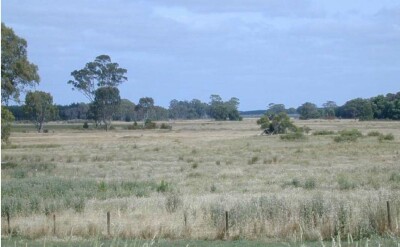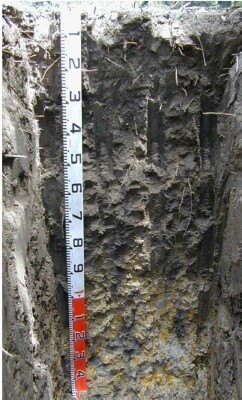GHF12a
Location: Dartmoor
Australian Soil Classification: Humose, Grey SODOSOL (very thick surface horizons)
General Landscape Description: Level plains
Site Description: Flat
Land Unit: Strathdownie
Geology: Quaternary lacustrine
General Land Unit Description: This land unit comprises the Quaternary lacustrine geology south of the Glenelg River. The lacustrine deposits include lagoonal, swamp and local colluvial deposits formed in low-lying wetlands and depressions between stranded beach ridges. Parent material in this land unit comprises of sand, silt, sandy clay, peat, marl and freshwater limestone, occurring in relatively unconsolidated forms.
The soils are variable throughout this land unit due to varying depositional environments. A common soil type is a strong texture contrast soil (Chromosol, Sodosol) commonly with a bleached A2 horizon and a mottled subsoil (indicative of impeded internal drainage). The sandy topsoil can be very deep in some soils. Vertosols are also common on the plains and swales in between the dunes. Podosols occur on the flats as well as on the dunes and that may have been mapped as part of this land unit due to restrictions of scale. Many of the soils are poorly drained and exhibit signs of a perched watertable.
1.5 year old Eucalyptus globulus plantation on ex-agricultural land. Remnant roots were observed to 150 cm, the pockets of dark grey sand in the B21 and B22 layers may have arisen due to previous (now remnant) root activity

Soil Profile Morphology
| A1 | 0-20 cm | Very dark greyish brown (10YR3/2) loamy sand; single grain structure; very weak consistence, dry; common medium roots present; pH 4.9; clear and smooth change to:
|  |
| A2 | 20-55 cm | Dark greyish brown (10YR4/2), loamy sand; single grain structure; loose consistence, moderately moist; common medium roots present; pH 5.7; clear and smooth change to:
| |
| A3 | 55-80 cm | Dark grey (10YR4/1), with many coarse faint dark yellowish brown (10YR4/4) mottles; sandy loam; weak course subangular blocky structure; loose consistence, moist; a few fine roots present; pH 7.0; clear and smooth change to:
| |
| Subsoil | |||
| B1 | 80-100 cm | Grey (10YR6/1), with many coarse distinct yellowish brown (10YR5/6) mottles, and dark grey sand (10YR4/1) on ped faces; sandy clay; weak course subangular blocky structure, parting to weak medium subangular blocky structure; very weak consistence when moist; pH 7.1; clear and smooth change to:
| |
| B21 | 100-140 cm | Grey (10YR6/1), with many coarse distinct brownish yellow (10YR6/8) mottles, and dark grey (10YR4/1) sand pockets; medium heavy clay, sandy; weak course subangular blocky structure, parting to weak medium subangular blocky structure; very weak consistence, moist; contains a few coarse ferruginous nodules; pH 7.8; diffuse and smooth change to:
| |
| B22 | 140-150 cm | Grey (10YR6/1), with many coarse distinct brownish yellow (10YR6/8) mottles, and dark grey sand (10YR4/1) pockets; medium clay, sandy; weak course subangular blocky structure parting to weak medium subangular blocky structure; very weak consistence, wet; contains common extremely coarse calcareous soft and hard nodules; changes to:
| |
| 150-230 cm | Grey; medium clay, sandy; sand pipes to 300 cm, with zones of sand along 50 mm wide cracks; changes to:
| ||
| 230-380 cm | Grey; clayey sand; changes to:
| ||
| 380-400 cm | Grey/yellow/brown; heavy clay. |
Soil Profile Characteristics:
- | pH | Salinity |
Surface Soil (A1 horizon) | Very Strongly Acid | Very Low |
Subsoil (80-100 cm) | Slightly Alkaline | Very Low |
Deeper Subsoil (100-140 cm) | Slightly Alkaline | Very Low |
Chemical and Physical Analysis:
Horizon | Horizon Depth (cm) | pH (water) | pH (CaCl2) | EC dS/m | Organic Carbon % | Total Nitrogen % | Exchangeable Aluminium ppm | Exchangeable Cations | |||
Ca | Mg | K | Na | ||||||||
meq/100g | |||||||||||
A1 | 0-20 | 4.9 | 4.2 | 0.06 | 3.3 | 0.18 | 24 | ||||
A2 | 20-55 | 5.7 | 4.9 | <0.05 | 0.4 | <0.05 | <10 | ||||
A3 | 55-80 | 7.0 | 6.3 | 0.06 | 0.38 | <0.05 | |||||
B1 | 80-100 | 7.1 | 6.2 | 0.06 | 0.28 | <0.05 | 4.2 | 3.3 | 0.11 | 0.28 | |
B21 | 100-140 | 7.8 | 6.9 | 0.07 | |||||||
Profile Described By: Ian Sargeant, Paul Feikema and Martin Clark, 5th December 2000.


